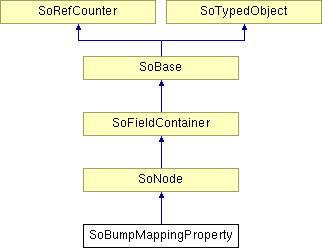SoBumpMappingProperty Class Reference
[FXViz]
 Bump mapping property node.
More...
Bump mapping property node.
More...
#include <FXViz/nodes/SoBumpMappingProperty.h>

Public Types | |
| enum | NormalMapSpace { TANGENT_SPACE = SoBumpMappingPropertyElement::TANGENT_SPACE, MODEL_SPACE = SoBumpMappingPropertyElement::MODEL_SPACE } |
| enum | TextureFormat { HEIGHT_MAP, NORMAL_MAP } |
Public Member Functions | |
| virtual SoType | getTypeId () const |
| SoBumpMappingProperty () | |
Static Public Member Functions | |
| static SoType | getClassTypeId () |
| static SbBool | isSupported () |
Public Attributes | |
| SoSFEnum | normalMapSpace |
| SoSFEnum | textureFormat |
| SoSFBool | isShadowed |
| SoSFBool | isEyeDistanceAttenuation |
| SoSFBool | isOnlyClosestLightUsed |
Detailed Description
 Bump mapping property node.
Bump mapping property node.
This node defines the current bump mapping properties for all subsequent shapes. However, currently, only SoFaceSet, SoQuadMesh, and SoTriangleStripSet support bump mapping. Two categories of properties can be defined:
- Texture properties
- Appearance properties
Texture Properties: The format of the bump map texture stored within the SoTexture2 is given by the textureFormat field. The SoTextureUnit::mappingMethod field indicates if the texture stored within SoTexture2 node is a bump map texture or not. This texture can be a "height map", which is a grayscale texture of height (TextureFormat::HEIGHT_MAP), or a "normal map", which is a 3-component texture of normals (TextureFormat::NORMAL_MAP) with x, y, and z corresponding to the red, green, and blue components respectively.
If the current SoTexture2 node does not contain a 3-component texture, specifying normal map format will have no bump mapping effect.
For a height map format, only the first component of each pixel is used. A height map texture is converted internally to a normal map.
Each normal in the normal map texture can be expressed either in the space of the object called "modeling space" or in the space of the face called "tangent space". The normalMapSpace field allows you to specify the desired coordinate system. The tangent space coordinate system is convenient for applying repetitive wrinkle patterns.
Appearance Properties: OpenGL Gouraud lighting is deactivated when a shape is rendered using the bump mapping technique. A pixel shader and a vertex shader are used instead for computing the lighting contribution per pixel according to the normals stored in the normal map.
Depending on the hardware capabilities, the number of passes (maximum 3) necessary to render a shape also depends on the number of lights, brightness of the shape, and texturing (or not) of the shape. In order to select a compromise between rendering quality and rendering performance, several fields are available:
- isOnlyClosestLightUsed: Indicates if only the closest light to the shape is used for the lighting computation. TRUE (default) improves performance by decreasing the number of rendering passes.
- isEyeDistanceAttenuation: Prevents a bumped face from smoothing with camera distance. Setting TRUE reduces performance.
- isShadowed: Activate/deactivate the self-shadow based on the geometric normal. Setting TRUE reduces performance.
FILE FORMAT/DEFAULT
- BumpMappingProperty {
| normalMapSpace | MODEL_SPACE |
| isShadowed | FALSE |
| isEyeDistanceAttenuation | FALSE |
| isOnlyClosestLightUsed | TRUE |
| textureFormat | NORMAL_MAP |
ACTION BEHAVIOR
- SoGLRenderAction, SoCallbackAction
Sets the current properties linked to the bump mapping. Sets: SoBumpMappingPropertyElement
SEE ALSO
SoTextureUnit, SoTexture2, SoAppearancePreserver.
- Deprecated:
-
Deprecated since Open Inventor 9400
No longer supported.
- See related examples:
Member Enumeration Documentation
Constructor & Destructor Documentation
| SoBumpMappingProperty::SoBumpMappingProperty | ( | ) |
Constructor.
Member Function Documentation
| static SoType SoBumpMappingProperty::getClassTypeId | ( | ) | [static] |
Returns the type identifier for this class.
Reimplemented from SoNode.
| virtual SoType SoBumpMappingProperty::getTypeId | ( | ) | const [virtual] |
Returns the type identifier for this specific instance.
Reimplemented from SoNode.
| static SbBool SoBumpMappingProperty::isSupported | ( | ) | [static] |
Indicates if bump mapping is supported by your graphics board.
When using a debug build of Open Inventor, some "no context available" warning messages may be generated. You can ignore them or see SoGLExtension for an example of using SoGLContext to avoid them.
Member Data Documentation
Eye distance attenuation.
Indicates if only the closest light (relative to the shape) is used or if all lights are used.
Activates/deactivates the lighting of unlit areas.
Specifies in which space normals in the normal map are expressed.
Indicates if the specified bump map texture in SoTexture2 is a height map or a normal map.
The documentation for this class was generated from the following file:
- FXViz/nodes/SoBumpMappingProperty.h